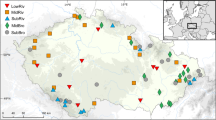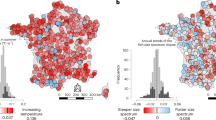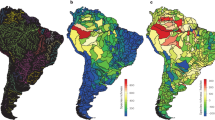Abstract
Climate change vulnerability depends on whether organisms can disperse rapidly enough to keep pace with shifting temperatures and find suitable habitat along the way. Here, we develop a method to examine where and for which species shifting isotherms will outpace species dispersal using stream networks of the southern Appalachian Mountains (United States) and their highly speciose and endemic fish fauna as a model system. By exploring alternative tributary and mainstem dispersal pathways, we identify tributaries as slow-climate-velocity pathways along which some fish can successfully disperse and thus keep pace with climate change. Despite accessibility and thermal suitability, non-temperature habitat conditions in tributaries are unsuitable for some dispersing species, thus probably precluding establishment of persistent populations. Our findings demonstrate a trade-off shaping the efficacy of thermal refugia that depends on species-specific habitat associations and reveal individual-level dispersal behaviour, body size and stream network geometry as general correlates of climate change vulnerability.
This is a preview of subscription content, access via your institution
Access options
Access Nature and 54 other Nature Portfolio journals
Get Nature+, our best-value online-access subscription
$29.99 / 30 days
cancel any time
Subscribe to this journal
Receive 12 digital issues and online access to articles
$119.00 per year
only $9.92 per issue
Buy this article
- Purchase on Springer Link
- Instant access to full article PDF
Prices may be subject to local taxes which are calculated during checkout




David Neely (e–h)

Similar content being viewed by others
Data availability
Dispersal traits are provided in Supplementary Table 5.
Code availability
Original R scripts and GIS layers generated and/or analysed are available on Figshare at https://doi.org/10.6084/m9.figshare.8948546.
Change history
22 September 2022
A Correction to this paper has been published: https://doi.org/10.1038/s41559-022-01874-0
References
IPCC Climate Change 2014: Synthesis Report (eds Core Writing Team, Pachauri, R. K. & Meyer L. A.) (IPCC, 2014).
Loarie, S. R. et al. The velocity of climate change. Nature 462, 1052–1055 (2009).
Chen, I. C., Hill, J. K., Ohlemüller, R., Roy, D. B. & Thomas, C. D. Rapid range shifts of species associated with high levels of climate warming. Science 333, 1024–1026 (2011).
Williams, S. E., Shoo, L. P., Isaac, J. L., Hoffmann, A. A. & Langham, G. Towards an integrated framework for assessing the vulnerability of species to climate change. PLoS Biol. 6, e325 (2008).
Dudgeon, D. et al. Freshwater biodiversity: importance, threats, status and conservation challenges. Biol. Rev. 81, 163–182 (2006).
Comte, L., Buisson, L., Daufresne, M. & Grenouillet, G. Climate‐induced changes in the distribution of freshwater fish: observed and predicted trends. Freshw. Biol. 58, 625–639 (2013).
Isaak, D. J. et al. Slow climate velocities of mountain streams portend their role as refugia for cold-water biodiversity. Proc. Natl Acad. Sci. USA 113, 4374–4379 (2016).
Comte, L. & Olden, J. D. Evidence for dispersal syndromes in freshwater fishes. Proc. R. Soc. Lond. B 285, 20172214 (2018).
Fagan, W. F. Connectivity, fragmentation, and extinction risk in dendritic metapopulations. Ecology 83, 3243–3249 (2002).
Hannah, L. et al. Fine-grain modeling of species’ response to climate change: holdouts, stepping-stones. Trends Ecol. Evol. 29, 390–397 (2014).
Vannote, R. L., Minshall, G. W., Cummins, K. W., Sedell, J. R. & Cushing, C. E. The river continuum concept. Can. J. Fish. Aquat. Sci. 37, 130–137 (1980).
Giam, X. & Olden, J. D. Drivers and interrelationships among multiple dimensions of rarity for freshwater fishes. Ecography 41, 331–344 (2018).
Giam, X. & Olden, J. D. Environment and predation govern fish community assembly in temperate streams. Glob. Ecol. Biogeogr. 10, 1194–1205 (2016).
Gibson-Reinemer, D. K., Rahel, F. J., Albeke, S. E. & Fitzpatrick, R. M. Natural and anthropogenic barriers to climate tracking in river fishes along a mountain–plains transition zone. Divers. Distrib. 23, 761–770 (2017).
Sunday, J. M. et al. Thermal-safety margins and the necessity of thermoregulatory behavior across latitude and elevation. Proc. Natl Acad. Sci. USA 111, 5610–5615 (2014).
Comte, L. & Olden, J. D. Climatic vulnerability of the world’s freshwater and marine fishes. Nat. Clim. Change 7, 718–722 (2017).
Walters A. W., Mandeville C. P. & Rahel F. J. The interaction of exposure and warming tolerance determines fish species vulnerability to warming stream temperatures. Biol. Lett. 14, 20180342 (2018).
Abell, R. et al. Freshwater ecoregions of the world: a new map of biogeographic units for freshwater biodiversity conservation. BioScience 58, 403–414 (2008).
Etnier, D. A. & Starnes, W. C. The Fishes of Tennessee (Univ. Tennessee Press, 1993).
Hill, R. A., Weber, M. H., Leibowitz, S. G., Olsen, A. R. & Thornbrugh, D. J. The stream‐catchment (StreamCat) dataset: a database of watershed metrics for the conterminous United States. J. Am. Water Resour. Assoc. 52, 120–128 (2016).
Wang, T., Hamann, A., Spittlehouse, D. & Carroll, C. Locally downscaled and spatially customizable climate data for historical and future periods for North America. PLoS ONE 11, e0156720 (2016).
Guisan, A. & Thuiller, W. Predicting species distribution: offering more than simple habitat models. Ecol. Lett. 8, 993–1009 (2005).
Radinger, J. & Wolter, C. Patterns and predictors of fish dispersal in rivers. Fish Fish. 15, 456–473 (2014).
Rodríguez, M. A. Restricted movement in stream fish: the paradigm is incomplete, not lost. Ecology 83, 1–13 (2002).
Hawkes, C. Linking movement behaviour, dispersal and population processes: is individual variation a key? J. Anim. Ecol. 78, 894–906 (2009).
Roberts, J. J., Fausch, K. D., Peterson, D. P. & Hooten, M. B. Fragmentation and thermal risks from climate change interact to affect persistence of native trout in the Colorado River basin. Glob. Change Biol. 19, 1383–1398 (2013).
Isaak, D. J. & Rieman, B. E. Stream isotherm shifts from climate change and implications for distributions of ectothermic organisms. Glob. Change Biol. 19, 742–751 (2013).
Higgins, S. I. & Richardson, D. M. Predicting plant migration rates in a changing world: the role of long-distance dispersal. Am. Nat. 153, 464–475 (1999).
Pimm, S. L., Jones, L. & Diamond, J. On the risk of extinction. Am. Nat. 132, 757–785 (1988).
Olden, J. D., Hogan, Z. S. & Vander Zanden, M. J. Small fish, big fish, red fish, blue fish: size-biased extinction risk of the world’s freshwater and marine fishes. Glob. Ecol. Biogeogr. 16, 694–701 (2007).
Colwell, R. K., Brehm, G., Cardelús, C. L., Gilman, A. C. & Longino, J. T. Global warming, elevational range shifts, and lowland biotic attrition in the wet tropics. Science 322, 258–261 (2008).
Benda, L. et al. The network dynamics hypothesis: how channel networks structure riverine habitats. BioScience 54, 413–427 (2004).
Torgersen, C. E., Price, D. M., Li, H. W. & McIntosh, B. A. Multiscale thermal refugia and stream habitat associations of Chinook salmon in northeastern Oregon. Ecol. Appl. 9, 301–319 (1999).
Schloss, C. A., Nuñez, T. A. & Lawler, J. J. Dispersal will limit ability of mammals to track climate change in the Western Hemisphere. Proc. Natl Acad. Sci. USA 109, 8606–8611 (2012).
Deutsch, C. A. et al. Impacts of climate warming on terrestrial ectotherms across latitude. Proc. Natl Acad. Sci. USA 105, 6668–6672 (2008).
Thomas, M. K., Kremer, C. T., Klausmeier, C. A. & Litchman, E. A global pattern of thermal adaptation in marine phytoplankton. Science 338, 1085–1089 (2012).
Comte, L. & Olden, J. D. Evolutionary and environmental determinants of freshwater fish thermal tolerance and plasticity. Glob. Change Biol. 23, 728–736 (2017).
Gunderson, A. R. & Stillman, J. H. Plasticity in thermal tolerance has limited potential to buffer ectotherms from global warming. Proc. R. Soc. Lond. B 282, 20150401 (2015).
Sheldon, K. S., Yang, S. & Tewksbury, J. J. Climate change and community disassembly: impacts of warming on tropical and temperate montane community structure. Ecol. Lett. 14, 1191–1200 (2011).
Hampe, A. & Petit, R. J. Conserving biodiversity under climate change: the rear edge matters. Ecol. Lett. 8, 461–467 (2005).
Nilsson, C., Reidy, C. A., Dynesius, M. & Revenga, C. Fragmentation and flow regulation of the world’s large river systems. Science 308, 405–408 (2005).
Mulholland, P. J. et al. Effects of climate change on freshwater ecosystems of the south‐eastern United States and the Gulf Coast of Mexico. Hydrol. Process. 11, 949–970 (1997).
Sun, L. et al. Regional Surface Climate Conditions in CMIP3 and CMIP5 for the United States: Differences, Similarities, and Implications for the U.S. National Climate Assessment (US Department of Commerce, 2015).
Xenopoulos, M. A. Scenarios of freshwater fish extinctions from climate change and water withdrawal. Glob. Change Biol. 11, 1557–1564 (2005).
Wenger, S. J., Luce, C. H., Hamlet, A. F., Isaak, D. J. & Neville, H. M. Macroscale hydrologic modeling of ecologically relevant flow metrics. Water Resour. Res. 46, W09513 (2010).
Seavy, N. E. et al. Why climate change makes riparian restoration more important than ever: recommendations for practice and research. Ecol. Restor. 27, 330–338 (2009).
Stanley, E. H. & Doyle, M. W. Trading off: the ecological effects of dam removal. Front. Ecol. Environ. 1, 15–22 (2003).
Noonan, M. J., Grant, J. W. & Jackson, C. D. A quantitative assessment of fish passage efficiency. Fish Fish. 13, 450–464 (2012).
Olden, J. D., Kennard, M. J., Lawler, J. J. & Poff, N. L. Challenges and opportunities in implementing managed relocation for conservation of freshwater species. Conserv. Biol. 25, 40–47 (2011).
Ball, I. R., Possingham, H. P. & Watts, M. in Spatial Conservation Prioritisation: Quantitative Methods and Computational Tools (eds Moilanen, A. et al.) Ch. 14 (Oxford Univ. Press, 2009).
Tingley, M. W., Koo, M. S., Moritz, C., Rush, A. C. & Beissinger, S. R. The push and pull of climate change causes heterogeneous shifts in avian elevational ranges. Glob. Change Biol. 18, 3279–3290 (2012).
Hasnain, S. S., Shuter, B. J. & Minns, C. K. Phylogeny influences the relationships linking key ecological thermal metrics for North American freshwater fish species. Can. J. Fish. Aquat. Sci. 70, 964–972 (2013).
Fluker, B. L., Kuhajda, B. R., Lang, N. J. & Harris, P. M. Low genetic diversity and small long-term population sizes in the spring endemic watercress darter, Etheostoma nuchale. Conserv. Genet. 11, 2267–2279 (2010).
Malone, E. W. et al. Which species, how many, and from where: integrating habitat suitability, population genomics, and abundance estimates into species reintroduction planning. Glob. Change Biol. 24, 3729–3748 (2018).
Nagel, D. et al. National Stream Internet Hydrography Network for Spatial-Stream-Network (SSN) Analysis: Rocky Mountain Research Station (US Forest Service Data Archive, 2017); https://www.fs.fed.us/rm/boise/AWAE/projects/NationalStreamInternet/NSI_network.html.
McKay, L. et al. NHDPlus Version 2: User Guide (USEPA, 2012); http://nctc.fws.gov/courses/references/tutorials/geospatial/CSP7306/Readings/NHDPlusV2_User_Guide.pdf
USEPA Best Practices for Continuous Monitoring of Temperature and Flow in Wadeable Streams (USFS, 2014).
Araújo, M. B. & New, M. Ensemble forecasting of species distributions. Trends Ecol. Evol. 22, 42–47 (2007).
Lyons, J. et al. Defining and characterizing coolwater streams and their fish assemblages in Michigan and Wisconsin, USA. North Am. J. Fish. Manage. 29, 1130–1151 (2009).
Caissie, D. The thermal regime of rivers: a review. Freshw. Biol. 51, 1389–1406 (2006).
DeWeber, J. T. & Wagner, T. A regional neural network ensemble for predicting mean daily river water temperature. J. Hydrol. 517, 187–200 (2014).
Hastie, T. J. & Tibshariani, R. J. Generalized Additive Models (Chapman & Hall, 1990).
Cutler, D. R. et al. Random forests for classification in ecology. Ecology 88, 2783–2792 (2007).
Peterson, E. E. & Ver Hoef, J. M. A mixed‐model moving‐average approach to geostatistical modeling in stream networks. Ecology 91, 644–651 (2010).
Kaushal, S. S. et al. Rising stream and river temperatures in the United States. Front. Ecol. Environ. 8, 461–466 (2010).
Luce, C. et al. Sensitivity of summer stream temperatures to climate variability in the Pacific Northwest. Water Resour. Res. 50, 3428–3443 (2014).
Dettinger, M. D. Projections and downscaling of 21st century temperatures, precipitation, radiative fluxes and winds for the Southwestern U.S., with focus on Lake Tahoe. Climatic Change 116, 17–33 (2012).
Hiemstra, P. H., Pebesma, E. J., Twenhöfel, C. J. & Heuvelink, G. B. Real-time automatic interpolation of ambient gamma dose rates from Dutch radioactivity monitoring network. Comput. Geosci. 35, 1711–1721 (2009).
Frimpong, E. A., Huang, J. & Liang, Y. IchthyMaps: a database of historical distributions of freshwater fishes of the United States. Fisheries 41, 590–599 (2016).
Huang, J. & Frimpong, E. A. Using historical atlas data to develop high-resolution distribution models of freshwater fishes. PLoS ONE 10, e0129995 (2015).
Phillips, S. J. et al. Sample selection bias and presence-only distribution models: implications for background and pseudo-absence data. Ecol. Appl. 19, 181–197 (2009).
Guisan, A., Thuiller, W. & Zimmerman, N. E. Habitat Suitability and Distribution Models: With Applications in R (Cambridge Univ. Press, 2017).
Digital Distribution Maps of the Freshwater Fishes in the Conterminous United States (NatureServe, 2010).
Frimpong, E. A. & Angermeier, P. L. Fish traits: a database of ecological and life-history traits of freshwater fishes of the United States. Fisheries 34, 487–495 (2010).
TpsDig v.1.4 (Department of Ecology and Evolution, State University New York, 2004); http://life.bio.sunysb.edu/morph/index.html
Revell, L. J. Phylogenetic signal and linear regression on species data. Methods Ecol. Evol. 1, 319–329 (2010).
Rabosky, D. L. et al. Rates of speciation and morphological evolution are correlated across the largest vertebrate radiation. Nat. Commun. 4, 1–8 (2013).
Ostroff, A., Wieferich, D., Cooper, A. & Infante, D. National Anthropogenic Barrier Dataset (NABD, 2013).
Acknowledgements
We thank members of the Giam Lab at the University of Tennessee for field assistance and discussions that improved the manuscript. Financial support was provided by a University of Tennessee start-up grant (E-011080132) awarded to X.G.
Author information
Authors and Affiliations
Contributions
M.J.T. and X.G. designed the research. M.J.T. led collection of the data. A.L.K. and J.C.M. contributed to data collation. M.J.T. led data analyses and X.G. contributed to data analyses. M.J.T. and X.G. wrote the manuscript.
Corresponding authors
Ethics declarations
Competing interests
The authors declare no competing interests.
Additional information
Publisher’s note: Springer Nature remains neutral with regard to jurisdictional claims in published maps and institutional affiliations.
Supplementary information
Supplementary Information
Supplementary Figs. 1–17 and Tables 1–6.
Supplementary Code 1
R script for fitting and projecting ENM for example species, E. chlorobranchium. The script uses two input datasets (Supplementary Dataset 3 and Supplementary Dataset 4), which are derived from the IchthyMaps dataset and the StreamCat dataset.
Supplementary Code 2
R script to identify upstream pathway with larger (mainstem) or smaller (tributary) catchment area of a focal reach. The script uses National Hydrography Dataset flowlines and associated attributes: ComID, UpHydroseq, DnHydroseq, Hydroseq, TotDASqKM.
Supplementary Dataset 1
Temperature parameters in the first sheet and definitions in the second sheet.
Supplementary Dataset 2
ENM habitat suitability in the first sheet and definitions in the second sheet.
Supplementary Dataset 3
Input dataset for environmental niche modelling script (see Supplementary Code 1).
Supplementary Dataset 4
Input dataset for environmental niche modelling script (see Supplementary Code 1).
Rights and permissions
About this article
Cite this article
Troia, M.J., Kaz, A.L., Niemeyer, J.C. et al. Species traits and reduced habitat suitability limit efficacy of climate change refugia in streams. Nat Ecol Evol 3, 1321–1330 (2019). https://doi.org/10.1038/s41559-019-0970-7
Received:
Accepted:
Published:
Issue Date:
DOI: https://doi.org/10.1038/s41559-019-0970-7
This article is cited by
-
The benefits of climate change mitigation to retaining rainbow trout habitat in British Columbia, Canada
Regional Environmental Change (2023)
-
Short-term paleogeographic reorganizations and climate events shaped diversification of North American freshwater gastropods over deep time
Scientific Reports (2022)
-
Threatened salmon rely on a rare life history strategy in a warming landscape
Nature Climate Change (2021)
-
Consistent population declines but idiosyncratic range shifts in Alpine orchids under global change
Nature Communications (2020)



